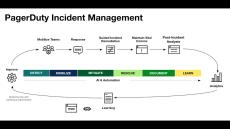|
By Debbie O'Brien
For someone experiencing a mental health or substance abuse crisis, receiving timely access to care is critical. Recognizing a growing need for behavioral health intervention, San Diego County launched its Telecare Mobile Crisis Response Team (MCRT) to provide no-cost, in-person support. “With mental health crises on the rise, counties are trying to figure out how to implement something that supports folks in the community,” said Bre Lane, Program Administrator at MCRT.
|
By Mandi Walls
Incidents impacting your customer and user-facing services can be stressful, both for the responders on your team who are working on a resolution, and for the other stakeholders in your business. For teams to solve incidents quickly and effectively, responders need to be able to trust each other and stakeholders have to trust the responders. This level of trust is hard to cultivate if your organization doesn’t have a significant amount of psychological safety.
|
By PagerDuty
98% of top tech execs paused their corporate genAI initiatives to establish policies. Execs say that a trusted technology partner is key to incorporating genAI into their organizations.
|
By PagerDuty
Offering includes innovations that provide end-to-end incident management to mitigate lost revenue and reputational risk while replacing point solutions.
|
By Laura Chu
Mitigating business risk is a key enterprise priority. To avoid unnecessary exposure to the business, technical teams need a proactive approach to managing incidents. While this is a well-known challenge, it’s also much easier said than done. Over the years, many organizations have cobbled together their own bespoke processes for managing different types of incidents.
|
By Lee Fredricks
There was recently some confusion in the office that I thought was worth researching and addressing. Depending on who you are talking to, you may hear the acronym DORA in one of two contexts. (OK, three if you’re talking to a preschooler!) It might be in relation to DORA metrics–that is, a set of metrics associated with DevOps Research and Assessment.
|
By PagerDuty
Spending on IT Operations projected to rise in 2024 with focus on security, cloud infrastructure and automation.
|
By Leigh Shevchik
Organizations must balance the day-to-day needs of the business with large-scale, long-term digital transformation as they continue to modernize their operations in service of growth. For our 2024 State of Digital Operations Report, we asked over 300 technical and business leaders at US-based Enterprise and upper Mid-Market companies about the challenges to their business and the initiatives they are prioritizing this year.
|
By Hannah Culver
Organizations looking to win the market and drive great customer experiences need to deliver on the promise of exceptional service, meaning fewer interruptions and faster resolution. This can be done by embedding automation across the incident management lifecycle for major incidents, and bringing in humans where it makes sense.
|
By Leigh Shevchik
As we reach the end of our blog series on the occurrences in 2023 from the fourth installment of our blog series, Restore: Repair vs. Root Cause, the unavoidable truth is that incidents are a universal challenge for organisations, regardless of their scale or field. In the APAC region, there’s a noticeable increase in regulatory bodies imposing strict penalties on major companies for service failures.
|
By PagerDuty
Elevate your biz & enhance your automation skills! Get together with the Rundeck by PagerDuty Process Automation crew and learn how automation is leading the way to innovation and fast tracking business for the future!🚀 Hear success automation stories from Diego Infiesta (IT Infrastructure Manager @ Ryanair) & Hans Erasmus (Director @ HBPS Consulting), and dive into the world of open-source automation with James Pickles (Solutions Consultant @ PagerDuty).
|
By PagerDuty
PagerDuty empowers teams of all kinds to do the critical work that moves business forward through the PagerDuty Operations Cloud.
|
By PagerDuty
The last year and a half has seen a massive uptake in using and building with #generativeAI, powered by large language models (LLMs). In this episode, we'll learn more about what it takes to deploy those LLMs into production with efficient and reliable monitoring and maintenance.
|
By PagerDuty
Build more resilient systems with Cross-Incident Insights. Jeli helps organizations connect the dots between incidents to identify patterns across tools and teams and surface actionable recommendations for continuous improvement.
|
By PagerDuty
PagerDuty Incident Management drives accountability with automated workflows and guided remediation, ensuring clear communication and action at all phases of the incident lifecycle.
|
By PagerDuty
What do new requirements to document and disclose security compliance mean for organizations? In this episode, we'll sit down with Andrés Vega, Technical Leader for the Security Technical Advisory Group at the Cloud Native Computing Foundation to hear about what's changed... and what's always been a good idea.
|
By PagerDuty
Want to deliver better customer experiences and meet your SLAs? PagerDuty for Customer Service Operations helps organizations connect the right teams at the right time, address urgent tickets, efficiently scale their 24-7 customer support model, and enhance cross-functional collaboration.
|
By PagerDuty
Looking for greater innovation velocity, improved operational efficiency, and better customer experiences? Learn how event-driven automation uses AI and ML to power major incident workflows end-to-end.
|
By PagerDuty
Not all incidents are created equal. How do you handle major incidents so that they don't spiral into a chaotic mess, incinerating productivity across too many teams? How do you prevent major incidents and learn from the ones you've had? "Major Incident Management" has been a practice for a long time, but as companies depend even more on digital services and revenue channels, while trying to do more with the same or less, something has to change.
|
By PagerDuty
How do highly regulated and bureaucratic organizations become more innovative to meet the needs of customers, citizens, and warfighters? We'll hear a perspective from Bryon Kroger on leading transformational change and the power of platforms in some of the most security-sensitive government agencies. Here are some of the resources mentioned in the interview.
|
By PagerDuty
To meet the rising demands of customers, organizations are being forced to scale their operations in ways that introduce additional complexity and chaos. More people are involved in operations and in incident response, across an ever-increasing mix of systems, applications, tools, and layers of abstraction, resulting in more and more risk to the business.
|
By PagerDuty
Given the speed at which technology and consumer expectations are changing, there are now significant gaps in existing ITSM approaches. As a result, ITSM and ITIL processes need to be modernized to address needs around integrating legacy processes and tools, to create workflows that are built around people to maximize flexibility and ease of use.
|
By PagerDuty
This study reviewed a combination of notification statistics and their impact on the well-being and work-life balance of human responders to help answer this question: When does on-call pain lead to employee attrition and how can it be avoided?
|
By PagerDuty
When your monitoring systems generate too many issues that require your attention, your organization starts to suffer from the phenomenon known as alert fatigue. Once alert fatigue sets in, it impacts the services you deliver to employees and customers. Teams become desensitized to alerts, which can cause them to miss critical notifications.
|
By PagerDuty
In this e-book, we introduce a new approach to AIOps that eliminates silos between event and incident management, has helped customers reduce noise on average by 98%, and supports both centralized and distributed workflows in harmony.
|
By PagerDuty
Organizations today require disruption in security management, which means not only modernizing security tools and best practices, but also involving more stakeholders in security ops, streamlining communication about security incidents, and coordinating responses efficiently and rapidly. It means embracing SecOps, a new approach to security management.
|
By PagerDuty
DevOps best practices can benefit all types of organizations, across all industries. Nearly half of enterprises have already begun adopting DevOps, and most of the remainder have plans to do so. If your org doesn't make the shift to DevOps, it risks being disrupted by others that achieve greater agility, automation, and communication.
|
By PagerDuty
In order to continue pleasing your customers in today's rapidly changing digital landscape, you need to adapt your customer support operations to meet this new set of expectations. Instant responses, zero service disruptions, and multiple channels of engagement are the new normal for customer relations. Companies that fail to live up to these ideals risk losing customers and falling behind.
|
By PagerDuty
How critical is incident resolution at your company? When the estimated cost of downtime is $7,900 a minute, how do you ensure you're setting yourself up for success with the right incident management solution?
|
By PagerDuty
From POS systems to QR systems, building management, mobile devices, IoT, and more, retailers must deliver a seamless omnichannel experience to stay ahead of the competition. But are you equipped to provide reliable digital services while continuing to deliver innovation?
- April 2024 (3)
- March 2024 (12)
- February 2024 (8)
- January 2024 (13)
- December 2023 (6)
- November 2023 (17)
- October 2023 (23)
- September 2023 (16)
- August 2023 (22)
- July 2023 (16)
- June 2023 (19)
- May 2023 (10)
- April 2023 (13)
- March 2023 (4)
- February 2023 (13)
- January 2023 (11)
- December 2022 (10)
- November 2022 (13)
- October 2022 (11)
- September 2022 (12)
- August 2022 (15)
- July 2022 (10)
- June 2022 (12)
- May 2022 (5)
- April 2022 (7)
- March 2022 (7)
- February 2022 (8)
- January 2022 (19)
- December 2021 (9)
- November 2021 (16)
- October 2021 (27)
- September 2021 (11)
- August 2021 (16)
- July 2021 (25)
- June 2021 (17)
- May 2021 (10)
- April 2021 (9)
- March 2021 (18)
- February 2021 (9)
- January 2021 (6)
- December 2020 (9)
- November 2020 (9)
- October 2020 (9)
- September 2020 (12)
- August 2020 (6)
- July 2020 (9)
- June 2020 (15)
- May 2020 (8)
- April 2020 (6)
- March 2020 (9)
- February 2020 (5)
- January 2020 (5)
- December 2019 (2)
- November 2019 (9)
- October 2019 (11)
- September 2019 (11)
- August 2019 (8)
- July 2019 (10)
- June 2019 (11)
- May 2019 (13)
- April 2019 (13)
- March 2019 (14)
- February 2019 (9)
- January 2019 (6)
- December 2018 (9)
- November 2018 (13)
- October 2018 (15)
- September 2018 (15)
- August 2018 (6)
- July 2018 (2)
- June 2018 (11)
- May 2018 (6)
- April 2018 (14)
- March 2018 (1)
- February 2018 (2)
- January 2018 (1)
Enterprise-grade incident management that helps you orchestrate the ideal response to create better customer, employee, and business value.
Visualize every dimension of the customer experience with contextual insights and interactive applications, and optimize response orchestration and continuous development and delivery:
- Event Intelligence: Understand the health and common context of disruptions across your entire infrastructure with actionable, time-series visualizations of correlated events.
- Modern Incident Response: All teams get the same visibility for technical and business response orchestration, enabling better collaboration and rapid resolution.
- Continuous Learning: Discover patterns in performance during build and in production for continuous delivery. View postmortem reports to analyze system efficiency and employee agility.

















